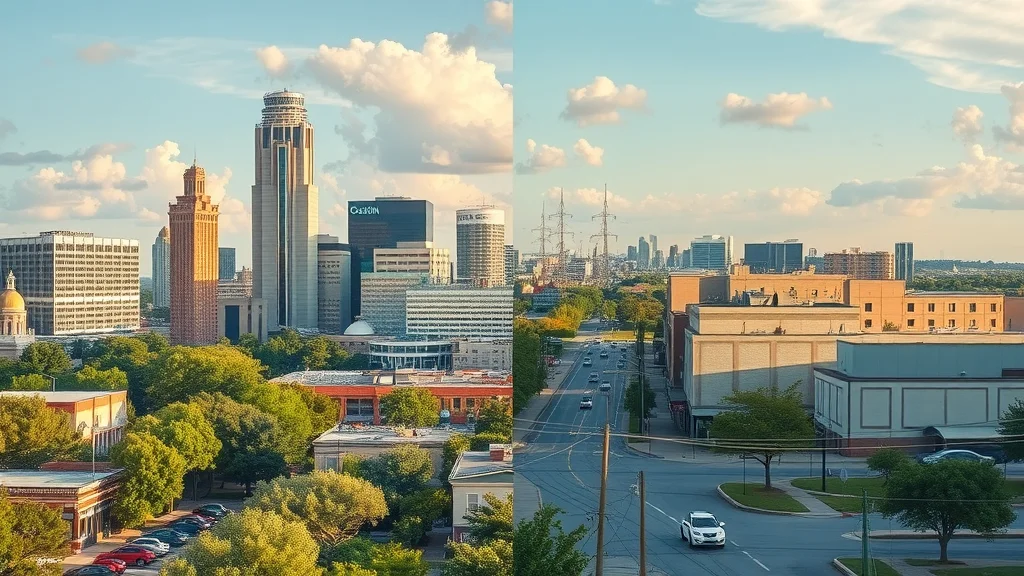Did you know that Austin’s population is increasing faster than every other major U.S. city, with an annual growth rate projected at 2.8% in 2024? This amazing surge isn’t just a number—it’s changing the local job market, housing scene, and even daily routines for everyone living in or moving to Austin. In this eye-opening article, we’ll explore how Austin's economic outlook and growth trends are transforming not just the city but your own opportunities, challenges, and lifestyle choices.

A Surprising Fact about Austin's Economic Outlook and Growth Trends
Here’s something few realize: Despite record-low unemployment and one of the nation’s highest surges in tech sector job growth, Austin is grappling with increased living costs that outpace many similar places to live—including nearby cities like Round Rock. For people considering where to move or invest, this divergence signals a need to look beyond headlines and ask how economic expansion affects everything from housing to average hourly wage, infrastructure stress, and community life.
What You'll Learn about Austin's Economic Outlook and Growth Trends
Key economic indicators shaping Austin's growth
How economic growth may affect your daily life
Major sectors and trends fueling transformation
Implications for jobs, housing, and cost of living
Austin's Economic Outlook and Growth Trends: A Personal Perspective
Living in the Austin metro area, it’s impossible not to notice the transformation underway. The skyline, once dominated by UT Austin’s iconic tower, now rivals that of many larger cities. This growth isn’t just for show—it’s powered by the spirit of innovation driving “Silicon Hills” and the flourishing life sciences boom that’s reshaping our job landscape and education hub, from Dell Technologies’ headquarters to the new medical school at UT Austin. But with every gain comes a challenge; increased demand is pushing up rental rates and median home prices, sparking new conversations in the Austin community about equity, affordability, and planning for future generations.
“Austin has consistently outpaced the nation in economic growth for the past decade—an economic indicator that both encourages opportunity and brings new challenges.”
As Austin continues to evolve, the city’s creative and cultural sectors are also experiencing a renaissance, with innovative collaborations and new artistic projects shaping the local identity. For a closer look at how Austin’s vibrant arts scene is contributing to its dynamic growth, explore the story behind Brian Eno and Beatie Wolfe’s collaborative albums and their impact on the city’s creative landscape.
Key Economic Indicators: Austin Economic Trends in 2024
Navigating Austin’s transformation means tracking the metrics that matter. Four key austin economic indicators stand out this year, highlighting the city’s economic health and forecasting what’s ahead for residents and investors alike. From unemployment rates that remain below the national average to a predicted spike in median home prices, these benchmarks offer a nuanced snapshot that helps explain why Austin is considered one of America’s most dynamic places to live and work.
Indicator |
2023 Value |
2024 Projection |
|---|---|---|
Population Growth Rate |
2.5% |
2.8% |
Unemployment Rate |
3.4% |
3.1% |
Median Home Price |
$512,000 |
$541,000 |
Tech Sector Job Growth |
4.2% |
4.5% |
How Austin Economic Indicators Compare to Round Rock and Other Places to Live
Across the Austin metro, cities like Round Rock offer a revealing contrast to Austin proper. While Austin’s growth rate is notable, Round Rock combines slightly slower population acceleration with more affordable homes and rental rates, attracting families seeking balance between career advancement and cost of living. Meanwhile, Austin’s focus on tech and life sciences means higher average hourly wage opportunities, but also a year over year jump in housing and everyday expenses. For anyone evaluating new places to live, these differences underscore the importance of researching economic indicators beyond city limits, considering regional trends, infrastructure, and educational investment from entities like the University of Texas at Austin and Dell Medical School.

Population acceleration and migration patterns
Cost of living and housing affordability
Tech and life sciences sector development
Quality of life and infrastructure
What Drives Austin's Economic Growth? Major Sectors and Opportunities
Austin’s explosive economic growth traces back to a handful of powerhouse industries. Tech remains the driving force—earning the city its “Silicon Hills” moniker—with giants like Dell Technologies and innovative startups expanding rapidly. Meanwhile, the professional and business services sector is seeing robust investments, alongside creative industries and a fast-evolving healthcare landscape. This sectoral diversity not only boosts gross domestic product but also fosters resilience, letting Austin outpace the average U.S. city in both economic recovery and year over year expansion. Additionally, local leadership, including partnerships between government, business, and universities like UT Austin, continue to draw skilled migrants and entrepreneurs eager to make a mark in one of the most exciting places to live in Texas and beyond.
The Life Sciences Boom: Austin's Next Big Economic Indicator
The ascent of life sciences has become one of the most important new threads in the fabric of Austin’s growth story. With institutional anchors like Dell Medical School and globally recognized companies moving in, the city is quickly becoming a hub for research, biotech, and medical device innovation. This sector not only creates thousands of high-skill jobs, but also increases demand for allied services—from clinical trials to bioinformatics—while attracting world-class talent. For students in UT Austin’s STEM programs and professionals eyeing a sector with decade-long job security, the life sciences boom is as promising as the initial tech influx of the 1990s, broadening Austin’s economic resilience and long-term outlook.

Watch:
How Austin's Economic Outlook and Growth Trends Impact Jobs and Employment
The impacts of Austin's economic outlook and growth trends ripple through the local job market in powerful ways. Tech sector hiring continues to rise, with average hourly wage figures sitting above state and national averages thanks to companies like Dell Technologies and a bustling environment of startups. At the same time, growth isn’t limited to tech; healthcare, professional and business services, and education are expanding too—from hospital systems partnering with Dell Medical School to a surge in enrollment and research funding at UT Austin. For those considering Austin or nearby Round Rock as places to live, employment stability and advancement in a range of sectors is making both the city and suburbs ever more attractive for young professionals, families, and innovators. Yet, swift expansion brings new questions about long-term job security, workplace competition, and skills demands, making it crucial for workers to stay agile and engaged with the region’s evolving economic indicators.
Rising demand in tech jobs
Growth in the healthcare and education sectors
Small business and entrepreneurial opportunities

Austin Economic Growth and Its Effects on Housing and Cost of Living
As economic growth intensifies, housing in Austin becomes both a beacon of opportunity and a lightning rod for concern. The median home price is expected to climb to $541,000 in 2024, and rental rate increases consistently outpace wage gains for many residents. This surge is due partly to high demand from new tech and life sciences professionals, but also reflects nationwide challenges in housing supply and affordability. Compared to Round Rock—which, with its lower median prices, remains a more accessible market—the central Austin area is at risk of pricing out longtime residents and creatives. Rising costs for daily essentials, transportation, and even city services add to the mix, putting pressure on city officials and the Austin community to address infrastructure bottlenecks, transit options, and support for low- and middle-income families.
"As Austin's economic indicators get stronger, challenges like affordability and traffic congestion become more urgent for everyday residents."

People Also Ask: Frequently Searched Questions about Austin's Economic Outlook and Growth Trends
Is Austin's economy expected to keep growing in 2024?
Answer: Current projections indicate that Austin's economy will continue to expand due to robust investments in technology, life sciences, and infrastructure.
How does Austin's cost of living compare to other places to live, like Round Rock?
Answer: Austin's cost of living is higher than Round Rock, mainly due to real estate prices and tech sector demand, though both cities offer high quality of life.
Which sectors are contributing to Austin economic indicators and future growth?
Answer: Technology, life sciences, education, and creative industries are primary drivers of Austin's economic growth and resilience.
Key Takeaways: What Austin's Economic Outlook and Growth Trends Mean for Residents
Austin's economic outlook and growth trends point to sustained prosperity but rising living costs.
Major growth sectors include tech and life sciences.
Regional comparisons highlight unique opportunities in nearby areas such as Round Rock.
Active civic participation can help address affordability and infrastructure concerns.

Frequently Asked Questions about Austin's Economic Outlook and Growth Trends
What are the main economic challenges facing Austin?
Austin confronts rising housing costs, increased traffic congestion, and growing disparities between high-income and low- to middle-income residents. Infrastructure resilience and service delivery are critical challenges as the city juggles rapid expansion with an inclusive vision for growth. A proactive approach is needed to ensure all residents benefit from historic levels of opportunity.Will growth slow down or speed up after 2024?
Current data suggests growth will not only remain steady but could accelerate, depending on national economic trends and local investments in tech, life sciences, and urban infrastructure. Key indicators such as population growth and unemployment rate projections consistently place Austin among top-performing American metropolitan areas.How can residents prepare for changes in the economic landscape?
Stay informed about local economic indicators, participate in Austin community decision-making, and consider upskilling through programs offered by the University of Texas and local partners. Renters and homeowners alike should watch for shifts in rental rate and home pricing, and plan proactively for transportation and lifestyle changes as the city grows.
Informed Decisions: Guide Your Financial and Lifestyle Choices by Following Austin's Economic Outlook and Growth Trends
As Austin’s economy transforms at record speed, knowledge isn’t just power—it’s your best asset for making smart choices about where to live, work, and invest. Keep a close eye on Austin's economic outlook and growth trends, compare key indicators with nearby places like Round Rock, and always stay engaged in the local Austin community to help shape a future that benefits everyone.
If you’re inspired by Austin’s rapid transformation and want to understand how creative innovation and economic growth intersect, there’s even more to discover. Exploring the city’s artistic revolutions—like the collaborative work of Brian Eno and Beatie Wolfe—can offer a fresh perspective on how culture and commerce fuel each other in thriving urban centers. Dive deeper into Austin’s evolving identity and see how the arts are helping to shape the city’s future by learning about the latest groundbreaking music collaborations and their influence on Austin’s growth. This journey into the creative side of Austin’s economy might just spark new ideas for your own path in this dynamic city.
 Add Element
Add Element  Add Row
Add Row 



Write A Comment